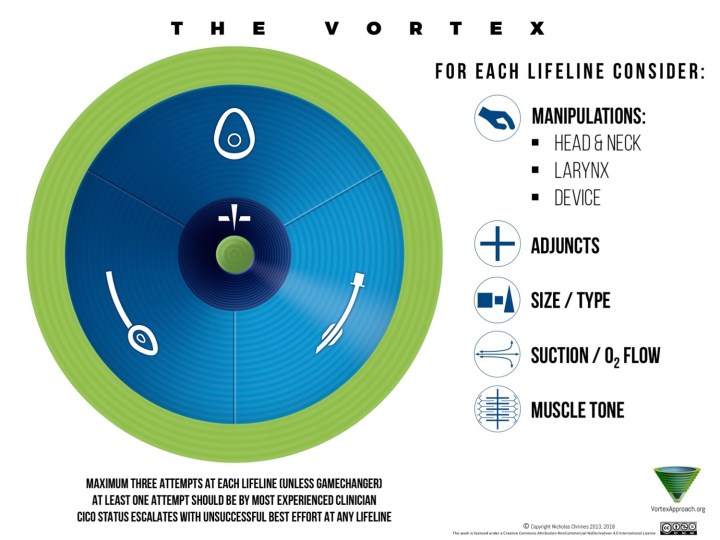Many of you involved in airway management will be familiar with the ‘Vortex Approach‘, the brainchild of anaesthetist Nicholas Chrimes and emergency physician Peter Fritz in Melbourne, Australia
Designed as a simple tool to open up communication in emergency airway management, the Vortex has been refined over the past few years and there is a slew of excellent educational resources available at VortexApproach.org
I find the Vortex is easy to teach and train to, representing one of the best cognitive tools out there for the whole team to use across an institution.
Unlike crisis algorithms for use solely in theatre by anaesthetists, The Vortex is based around a “high acuity implementation tool”, specifically designed to be used during the high-stakes, time critical situation of an evolving airway emergency. It is intended to help clinical teams perform under pressure by providing a simple, consistent template that can be taught to all clinicians involved in advanced airway management, irrespective of critical care discipline and whether they are from a medical, nursing or paramedical background. It is also able to be used in any context in which an airway management takes place

The simplicity of the three user airway lifelines (bag-mask ventilation, supraglottic airway and endotracheal option) with the reinforcement of green zones of safety as one enters/exits ‘the vortex’ of ensuring adequate alveolar oxygenation is useful….as is the reinforcement of using five optimisation strategies (manipulation, size/type of device, adjuncts, flow/suction, muscle tone).
Failure to establish an effective lifeline or optimisation strategy will lead to the final ‘lifeline’ at the bottom of the Vortex – CICO.
Whilst I have found the Vortex to be easy to teach, there are increasing levels of nuance to the model which may not be appreciated.
To accelerate understanding and explore deeper learning of The Vortex, a small group of us in the closed Facebook group ‘Rural Anaesthesia Down Under’ have collaborated (along with Vortex creator Nick Chrimes) to develop a 3D model of the Vortex. Huge kudos here to Dr Philip Cohen, a fellow FACRRM (who coincidentally will soon be moving to Kangaroo Island) who has spent hundred of hours in refining the 3D files for use. Kudos.
The files for this are now available for folk to 3D print themselves – options include personal printer (for those enthusiasts with a 3D printer and tech-savvy), or taking to a commercial outlet such as Officeworks etc. A cheaper option may be to outsource to Airtasker…and this proved to be a useful adjunct to refine files and colouring in the final design stages.
Initial experience in using the model for teaching is overwhelmingly positive – being able to pick it up and explore makes the Vortex ‘come alive’ – it also allows one to rapidly enter ‘hypothetical scenarios’ as a tabletop exercise, using the Vortex to explore options and correct errors. We love it!
Anyhow – the files are available on Thingiverse
https://www.thingiverse.com/thing:3651761
There’s even a small file to allow you to print a Vortex key ring!
What next, Vortex coffee cups?
Vortex swag is indicated here, along with an airway management board game.